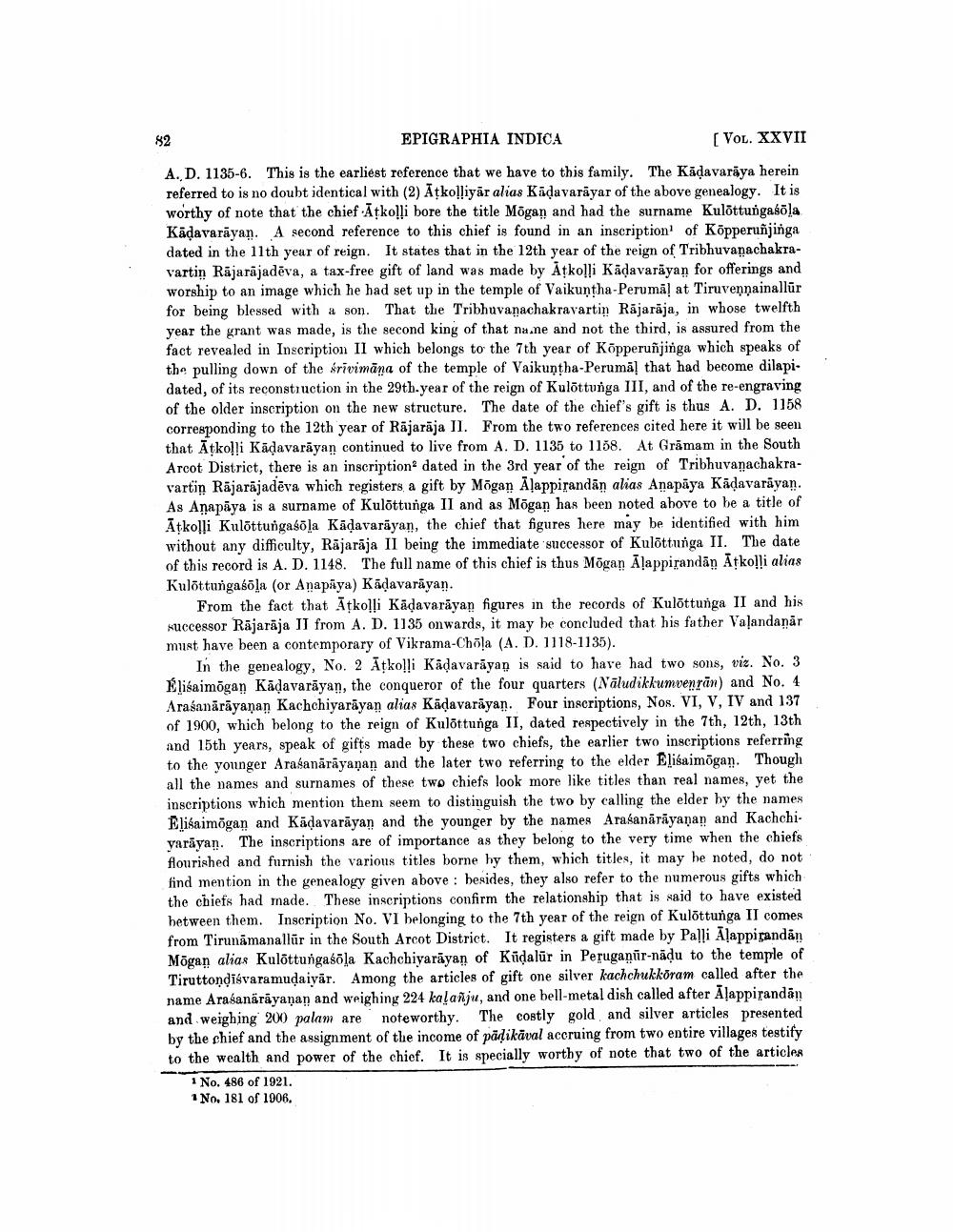________________
82
EPIGRAPHIA INDICA
(Vol. XXVII
A. D. 1135-6. This is the earliest reference that we have to this family. The Kādavarāya herein referred to is no doubt identical with (2) Ātkolliyār alias Kādavarayar of the above genealogy. It is worthy of note that the chief Atkolli bore the title Mögan and had the surname Kulõttungasola Kadavarāvan. A second reference to this chief is found in an inscription of Köpperuñjinga dated in the 11th year of reign. It states that in the 12th year of the reign of Tribhuvanachakravartin Rajarajadēva, a tax-free gift of land was made by Atkolli Kadavarāyan for offerings and worship to an image which he had set up in the temple of Vaikuntha-Perumā! at Tiruveņņainallūr for being blessed with a son. That the Tribhuvanachakravartin Rājarāja, in whose twelfth year the grant was made, is the second king of that na.ne and not the third, is assured from the fact revealed in Inscription Il which belongs to the 7th year of KÕpperusjinga which speaks of the pulling down of the krivimāna of the temple of Vaikuntha-Perumal that had become dilapi. dated, of its reconstruction in the 29th.year of the reign of Kulöttunga III, and of the re-engraving of the older inscription on the new structure. The date of the chief's gift is thus A. D. 1158 corresponding to the 12th year of Rājarāja II. From the two references cited here it will be seen that Ātkolli Kādavarāyan continued to live from A. D. 1135 to 1158. At Grāmam in the South Arcot District, there is an inscription dated in the 3rd year of the reign of Tribhuvanachakravartin Räjarājadēva which registers a gift by Mögan Alappirandān alias Anapaya Kādavarāyan. As Anapāya is a surname of Kulõttunga II and as Mögan has been noted above to be a title of Atkolli Kulottungasola Kādavarāyan, the chief that figures here may be identified with him without any difficulty, Räjarāja Il being the immediate successor of Kulõttunga II. The date of this record is A. D. 1148. The full name of this chief is thus Mögan Ālappirandān Atkolli alias Kulõttungaśāla (or Anapāya) Kādavarāyan.
From the fact that Ātkolli Kādavarāyan figures in the records of Kulõttunga II and his successor Rājarāja II from A. D. 1135 onwards, it may be concluded that his father Valandanar must have been a contemporary of Vikrama-Chöļa (A.D. 1118-1135).
In the genealogy, No. 2 Ātkolli Kadavarāyan is said to have had two sons, viz. No. 3 Élisaimõgan Kādavarāyan, the conqueror of the four quarters (Nāludikkumvenrān) and No. 4 Arašanārāyanan Kachchiyarāyan alias Kädavarāyan. Four inscriptions, Nos. VI, V, IV and 137 of 1900, which belong to the reign of Kulõttunga II, dated respectively in the 7th, 12th, 13th and 15th years, speak of gifts made by these two chiefs, the earlier two inscriptions referring to the younger Arašanārāyaṇan and the later two referring to the elder Elisaimõgan. Though all the names and surnames of these two chiefs look more like titles than real names, yet the inscriptions which mention them seem to distinguish the two by calling the elder by the names Elisaimõgan and Kadavarāyan and the younger by the names Arašanārāyanan and Kachchiyarāyan. The inscriptions are of importance as they belong to the very time when the chiefs flourished and furnish the various titles borne hy them, which titles, it may be noted, do not find mention in the genealogy given above : besides, they also refer to the numerous gifts which the chiefs had made. These inscriptions confirm the relationship that is said to have existed between them. Inscription No. VI belonging to the 7th year of the reign of Kulõttunga II comes from Tirunāmanallur in the South Arcot District. It registers a gift made by Palli Alappiçandan Mögan alias Kulottungaśāla Kachchiyarāyan of Kūdalūr in Peruganīr-nādu to the temple of Tiruttondisvaramudaiyār. Among the articles of gift one silver kachchukkoram called after the name Arasanarayanan and weighing 224 kalanju, and one bell-metal dish called after Ālappirandan and weighing 200 palam are noteworthy. The costly gold and silver articles presented by the chief and the assignment of the income of päļikäval aceruing from two entire villages testify to the wealth and power of the chief. It is specially worthy of note that two of the articles
1 No. 486 of 1921. 1 No. 181 of 1906.




